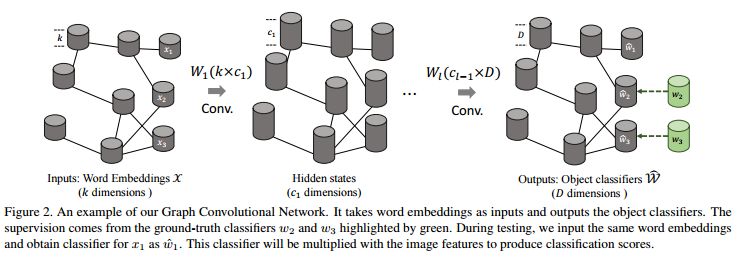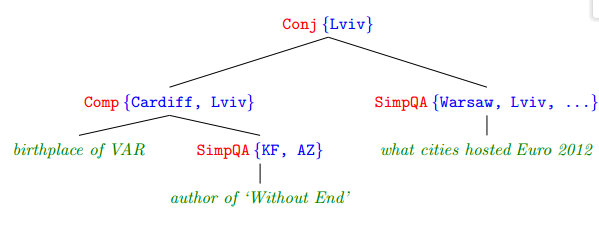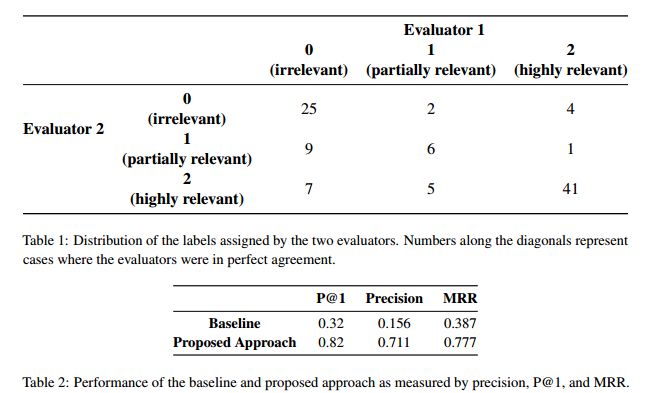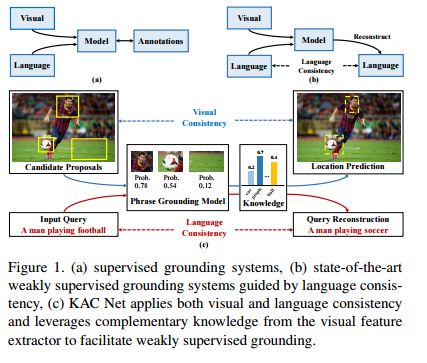【论文推荐】最新七篇知识图谱相关论文—嵌入式知识、Zero-shot识别、知识图谱嵌入、网络库、变分推理、解释、弱监督
【导读】专知内容组整理了最近七篇知识图谱(Knowledge graphs)相关文章,为大家进行介绍,欢迎查看!
1.Learning over Knowledge-Base Embeddings for Recommendation (学习基于嵌入式知识的推荐)
作者:Yongfeng Zhang,Qingyao Ai,Xu Chen,Pengfei Wang
摘要:State-of-the-art recommendation algorithms -- especially the collaborative filtering (CF) based approaches with shallow or deep models -- usually work with various unstructured information sources for recommendation, such as textual reviews, visual images, and various implicit or explicit feedbacks. Though structured knowledge bases were considered in content-based approaches, they have been largely neglected recently due to the availability of vast amount of data, and the learning power of many complex models. However, structured knowledge bases exhibit unique advantages in personalized recommendation systems. When the explicit knowledge about users and items is considered for recommendation, the system could provide highly customized recommendations based on users' historical behaviors. A great challenge for using knowledge bases for recommendation is how to integrated large-scale structured and unstructured data, while taking advantage of collaborative filtering for highly accurate performance. Recent achievements on knowledge base embedding sheds light on this problem, which makes it possible to learn user and item representations while preserving the structure of their relationship with external knowledge. In this work, we propose to reason over knowledge base embeddings for personalized recommendation. Specifically, we propose a knowledge base representation learning approach to embed heterogeneous entities for recommendation. Experimental results on real-world dataset verified the superior performance of our approach compared with state-of-the-art baselines.
期刊:arXiv, 2018年3月23日
网址:
http://www.zhuanzhi.ai/document/4a7f93d4541c08412376c92c7ac72f98
2. Zero-shot Recognition via Semantic Embeddings and Knowledge Graphs(通过语义嵌入和知识图谱实现Zero-shot识别)
作者:Xiaolong Wang,Yufei Ye,Abhinav Gupta
机构:The Robotics Institute, Carnegie Mellon University
摘要:We consider the problem of zero-shot recognition: learning a visual classifier for a category with zero training examples, just using the word embedding of the category and its relationship to other categories, which visual data are provided. The key to dealing with the unfamiliar or novel category is to transfer knowledge obtained from familiar classes to describe the unfamiliar class. In this paper, we build upon the recently introduced Graph Convolutional Network (GCN) and propose an approach that uses both semantic embeddings and the categorical relationships to predict the classifiers. Given a learned knowledge graph (KG), our approach takes as input semantic embeddings for each node (representing visual category). After a series of graph convolutions, we predict the visual classifier for each category. During training, the visual classifiers for a few categories are given to learn the GCN parameters. At test time, these filters are used to predict the visual classifiers of unseen categories. We show that our approach is robust to noise in the KG. More importantly, our approach provides significant improvement in performance compared to the current state-of-the-art results (from 2 ~ 3% on some metrics to whopping 20% on a few).
期刊:arXiv, 2018年3月22日
网址:
http://www.zhuanzhi.ai/document/a7c8ea9e5f2ee71718e03e71bf140ffe
3. Expeditious Generation of Knowledge Graph Embeddings(快速生成知识图谱嵌入)
作者:Tommaso Soru,Stefano Ruberto,Diego Moussallem,Edgard Marx,Diego Esteves,Axel-Cyrille Ngonga Ngomo
机构:University of Bonn,Paderborn University
摘要:Knowledge Graph Embedding methods aim at representing entities and relations in a knowledge base as points or vectors in a continuous vector space. Several approaches using embeddings have shown promising results on tasks such as link prediction, entity recommendation, question answering, and triplet classification. However, only a few methods can compute low-dimensional embeddings of very large knowledge bases. In this paper, we propose KG2Vec, a novel approach to Knowledge Graph Embedding based on the skip-gram model. Instead of using a predefined scoring function, we learn it relying on Long Short-Term Memories. We evaluated the goodness of our embeddings on knowledge graph completion and show that KG2Vec is comparable to the quality of the scalable state-of-the-art approaches and can process large graphs by parsing more than a hundred million triples in less than 6 hours on common hardware.
期刊:arXiv, 2018年3月21日
网址:
http://www.zhuanzhi.ai/document/e707f89e3a3bc1474e34d9ce4ad4928c
4. The Web as a Knowledge-base for Answering Complex Questions(基于网络知识库的复杂问答)
作者:Alon Talmor,Jonathan Berant
机构:Tel-Aviv University
摘要:Answering complex questions is a time-consuming activity for humans that requires reasoning and integration of information. Recent work on reading comprehension made headway in answering simple questions, but tackling complex questions is still an ongoing research challenge. Conversely, semantic parsers have been successful at handling compositionality, but only when the information resides in a target knowledge-base. In this paper, we present a novel framework for answering broad and complex questions, assuming answering simple questions is possible using a search engine and a reading comprehension model. We propose to decompose complex questions into a sequence of simple questions, and compute the final answer from the sequence of answers. To illustrate the viability of our approach, we create a new dataset of complex questions, ComplexWebQuestions, and present a model that decomposes questions and interacts with the web to compute an answer. We empirically demonstrate that question decomposition improves performance from 20.8 precision@1 to 27.5 precision@1 on this new dataset.
期刊:arXiv, 2018年3月18日
网址:
http://www.zhuanzhi.ai/document/877232e5fa767722b5d1277cd822a82e
5. Variational Knowledge Graph Reasoning(变分知识图谱推理)
作者:Wenhu Chen,Wenhan Xiong,Xifeng Yan,William Wang
机构:University of California
摘要:Inferring missing links in knowledge graphs (KG) has attracted a lot of attention from the research community. In this paper, we tackle a practical query answering task involving predicting the relation of a given entity pair. We frame this prediction problem as an inference problem in a probabilistic graphical model and aim at resolving it from a variational inference perspective. In order to model the relation between the query entity pair, we assume that there exist underlying latent variables (assemble of all paths connecting these two nodes) in the KG, which carries the equivalent semantics of their relation. However, due to the intractability of connections in large KGs, we propose to use variation inference to maximize the evidence lower bound. More specifically, our framework (\textsc{Diva}) is composed of three modules, i.e. a posterior approximator, a prior (path finder), and a likelihood (path reasoner). By using variational inference, we are able to incorporate them closely into a unified architecture and jointly optimize them to perform KG reasoning. With active interactions among these sub-modules, \textsc{Diva} is better at handling noise and cope with more complex reasoning scenarios. In order to evaluate our method, we conduct the experiment of the link prediction task on NELL-995 and FB15K datasets and achieve state-of-the-art performances on both datasets.
期刊:arXiv, 2018年3月18日
网址:
http://www.zhuanzhi.ai/document/1e1d09b55cc3d4f695b7f080a779f2c3
6.Tell Me Why Is It So? Explaining Knowledge Graph Relationships by Finding Descriptive Support Passages(告诉我为什么会这样?通过寻找描述性的支持段落来解释知识图谱关系)
作者:Sumit Bhatia,Purusharth Dwivedi,Avneet Kaur
摘要:We address the problem of finding descriptive explanations of facts stored in a knowledge graph. This is important in high-risk domains such as healthcare, intelligence, etc. where users need additional information for decision making and is especially crucial for applications that rely on automatically constructed knowledge bases where machine learned systems extract facts from an input corpus and working of the extractors is opaque to the end-user. We follow an approach inspired from information retrieval and propose a simple and efficient, yet effective solution that takes into account passage level as well as document level properties to produce a ranked list of passages describing a given input relation. We test our approach using Wikidata as the knowledge base and Wikipedia as the source corpus and report results of user studies conducted to study the effectiveness of our proposed model.
期刊:arXiv, 2018年3月18日
网址:
http://www.zhuanzhi.ai/document/307dee0ffc91a5ab5554d48f0ac99eb9
7. Knowledge Aided Consistency for Weakly Supervised Phrase Grounding
作者:Kan Chen,Jiyang Gao,Ram Nevatia
机构:University of Southern California
摘要:Given a natural language query, a phrase grounding system aims to localize mentioned objects in an image. In weakly supervised scenario, mapping between image regions (i.e., proposals) and language is not available in the training set. Previous methods address this deficiency by training a grounding system via learning to reconstruct language information contained in input queries from predicted proposals. However, the optimization is solely guided by the reconstruction loss from the language modality, and ignores rich visual information contained in proposals and useful cues from external knowledge. In this paper, we explore the consistency contained in both visual and language modalities, and leverage complementary external knowledge to facilitate weakly supervised grounding. We propose a novel Knowledge Aided Consistency Network (KAC Net) which is optimized by reconstructing input query and proposal's information. To leverage complementary knowledge contained in the visual features, we introduce a Knowledge Based Pooling (KBP) gate to focus on query-related proposals. Experiments show that KAC Net provides a significant improvement on two popular datasets.
期刊:arXiv, 2018年3月11日
网址:
http://www.zhuanzhi.ai/document/1910295ea38cfb4dba229bd68c87bd3e
-END-
专 · 知
人工智能领域主题知识资料查看获取:【专知荟萃】人工智能领域26个主题知识资料全集(入门/进阶/论文/综述/视频/专家等)
同时欢迎各位用户进行专知投稿,详情请点击:
【诚邀】专知诚挚邀请各位专业者加入AI创作者计划!了解使用专知!
请PC登录www.zhuanzhi.ai或者点击阅读原文,注册登录专知,获取更多AI知识资料!
请扫一扫如下二维码关注我们的公众号,获取人工智能的专业知识!
请加专知小助手微信(Rancho_Fang),加入专知主题人工智能群交流!加入专知主题群(请备注主题类型:AI、NLP、CV、 KG等)交流~
点击“阅读原文”,使用专知!












